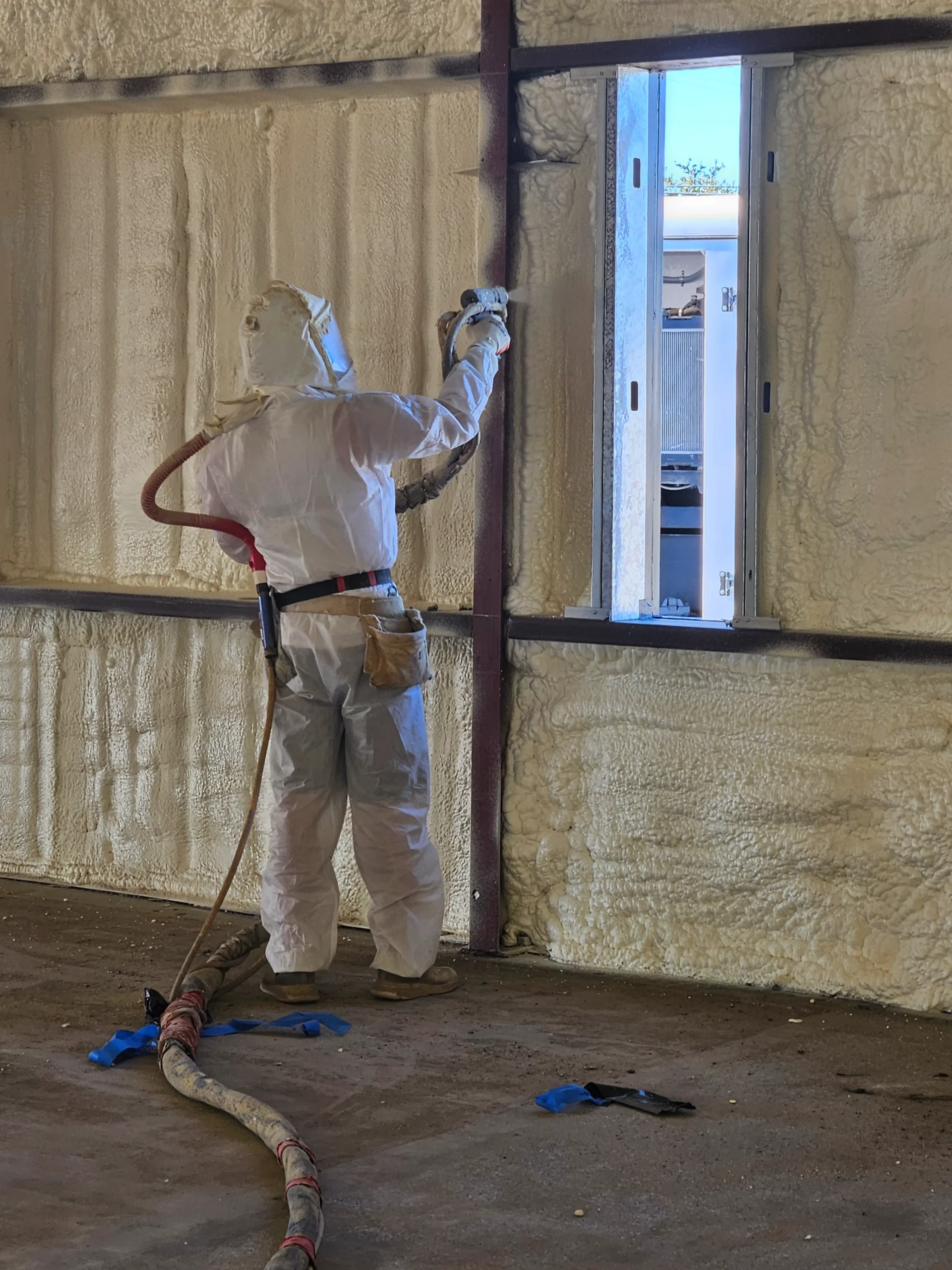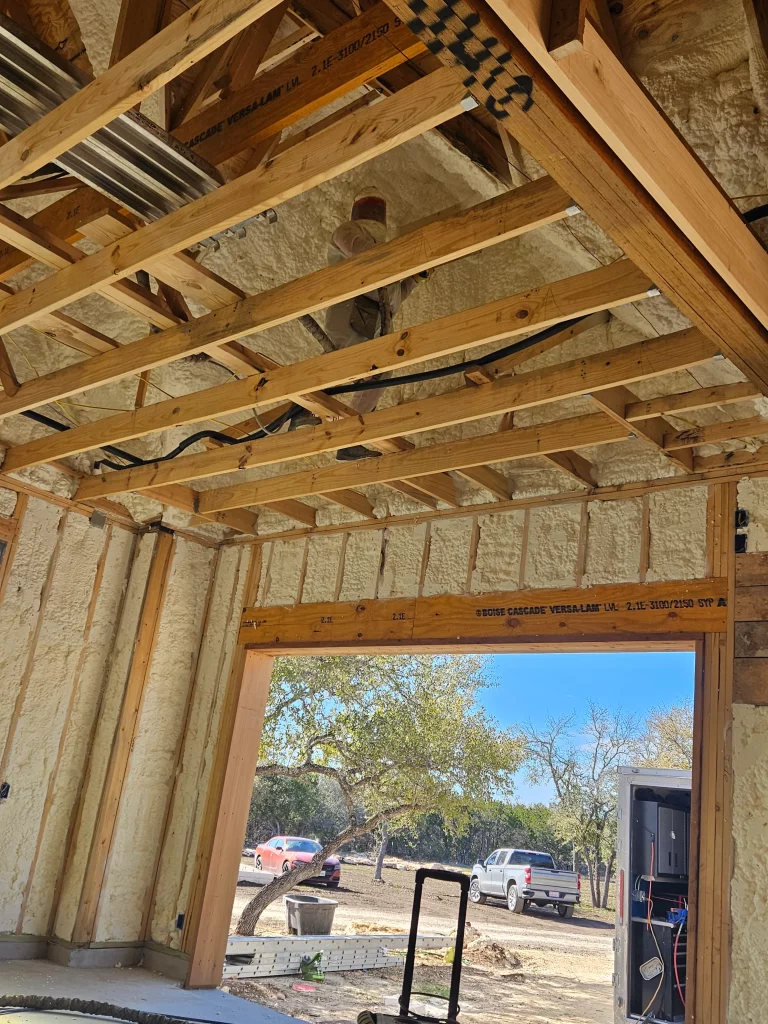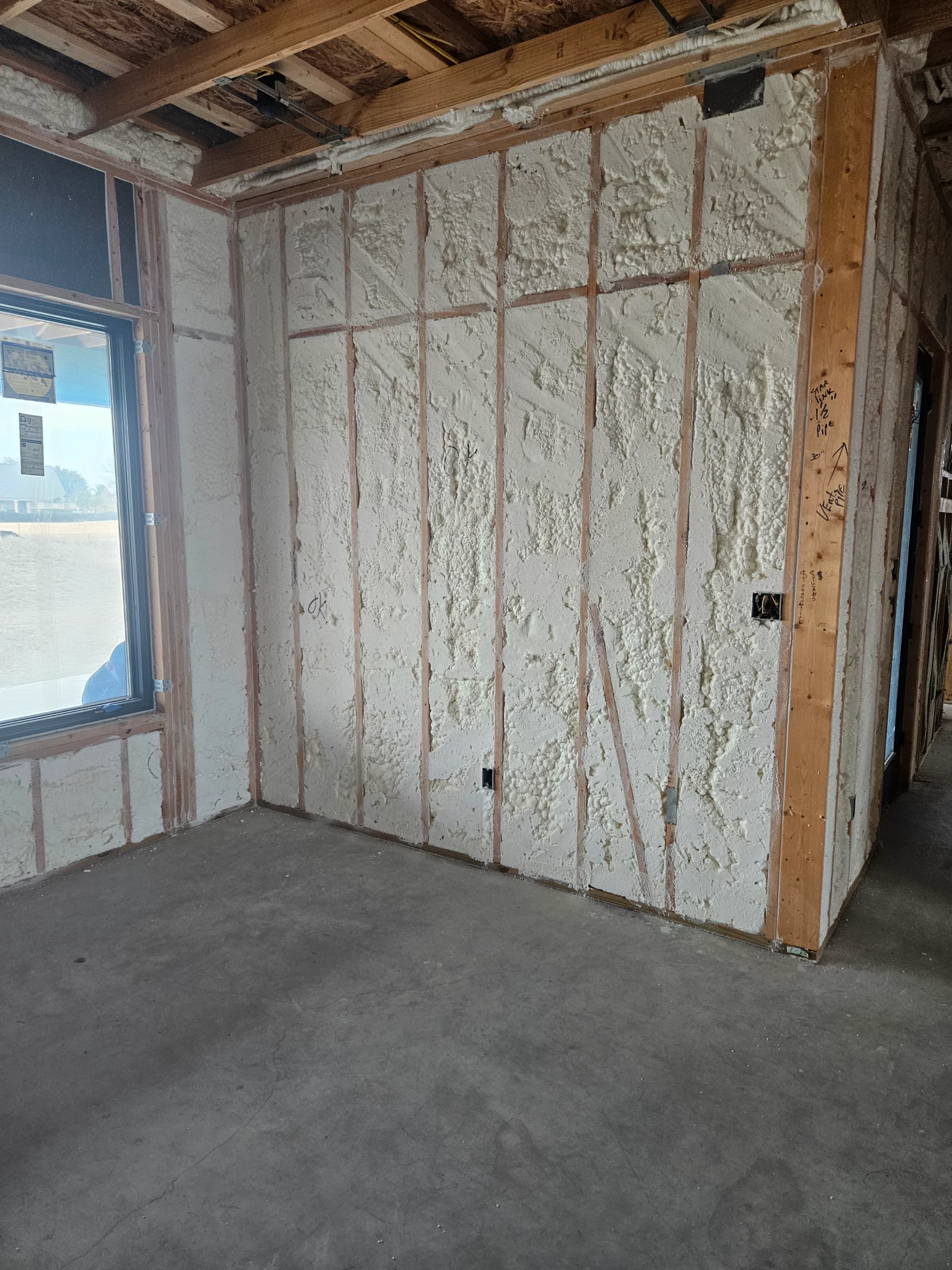

Spray foam insulation protects Georgetown homes from extreme heat by creating an airtight thermal barrier that blocks radiant heat transfer and prevents conditioned air from escaping. This comprehensive insulation solution reduces cooling costs by 30-50% during Central Texas summers when temperatures regularly exceed 100°F, while maintaining consistent indoor temperatures regardless of external heat conditions.
The superior thermal performance stems from spray foam’s unique cellular structure and seamless application method, which eliminates thermal bridging and air infiltration that plague traditional insulation materials. Georgetown homeowners experience immediate comfort improvements and long-term energy savings when properly installed spray foam systems replace conventional fiberglass or cellulose insulation.
This analysis draws from extensive field experience installing spray foam systems in over 500 Central Texas homes, combined with thermal performance data collected during Georgetown’s record-breaking heat waves. The information provided focuses on practical heat protection strategies specifically relevant to the challenging climate conditions found in Williamson County.
Georgetown’s location in Central Texas subjects homes to three primary heat transfer mechanisms that drive up cooling costs and reduce comfort. Radiant heat from intense summer sun penetrates through roofing materials and attic spaces, while conductive heat travels through walls, windows, and structural elements. Air infiltration allows hot outdoor air to enter homes while pushing cooled indoor air outside through gaps and cracks.
Traditional insulation materials struggle against Georgetown’s extreme heat because they only address conductive heat transfer while ignoring air infiltration. Fiberglass batts compress over time, creating gaps that allow hot air movement, while rigid foam boards develop separation joints that become thermal weak points during temperature cycling.
Spray foam insulation addresses all three heat transfer modes simultaneously through its expanding cellular structure and chemical bonding properties. The material expands to fill every gap, crack, and irregular surface while curing into a rigid barrier that maintains its seal integrity throughout temperature fluctuations.
| Heat Transfer Type | Traditional Insulation Performance | Spray Foam Performance | Georgetown Climate Impact |
|---|---|---|---|
| Conductive | R-3.1 per inch (fiberglass) | R-6.5 per inch (closed-cell) | 110% better thermal resistance |
| Radiant | Minimal protection | High reflectivity | Blocks 97% of radiant heat |
| Air Infiltration | 15-40% energy loss | <0.02 air changes | Eliminates hot air penetration |
| Moisture Control | Absorbs humidity | Vapor barrier properties | Prevents humidity infiltration |
Georgetown experiences approximately 90-100 days annually with temperatures above 95°F, creating sustained thermal stress on building envelopes. The region’s clay soil composition causes foundation movement that creates new air infiltration pathways in traditionally insulated homes, while limestone bedrock reflects additional ground heat upward.
Bonus Tip: Georgetown’s elevation change from 750 to 850 feet above sea level creates microclimates within the city. Homes on higher elevations receive more intense solar radiation and require enhanced radiant heat protection, while lower areas experience greater humidity infiltration challenges.
Spray foam insulation maintains its protective properties throughout Georgetown’s temperature extremes because the material’s chemical structure remains stable from -40°F to 180°F. This stability ensures consistent performance during heat waves when attic temperatures reach 140-160°F, conditions that cause traditional insulation materials to degrade or lose effectiveness.
| Performance Metric | Closed-Cell Spray Foam | Open-Cell Spray Foam | Georgetown Climate Benefit |
|---|---|---|---|
| R-Value per inch | 6.0-6.5 | 3.6-3.8 | Superior thermal resistance |
| Air permeability | 0.02 perm | 16 perms | Moisture control variation |
| Structural strength | 35-50 psi | 0.5-1.0 psi | Wind uplift resistance |
| Temperature range | -40°F to 180°F | -40°F to 180°F | Stable in extreme heat |
| Expansion ratio | 30:1 | 100:1 | Complete gap sealing |
| Curing time | 24-48 hours | 8-24 hours | Quick installation benefit |
According to the Texas State Energy Conservation Office, properly installed spray foam insulation reduces cooling energy consumption by 35-50% in Central Texas homes compared to code-minimum fiberglass insulation. Georgetown Municipal Electric Department reports that homes with comprehensive spray foam systems maintain 73-75°F indoor temperatures with 40% less air conditioning runtime during peak summer months.
Bonus Tip: Georgetown’s peak electricity demand occurs between 3-7 PM when outdoor temperatures reach daily maximums. Spray foam’s thermal mass effect delays heat penetration by 4-6 hours, shifting peak cooling loads to evening hours when electricity rates are lower under time-of-use programs.
The National Association of Home Builders studied 200 Central Texas homes and found spray foam installations delivered average annual cooling cost reductions of $1,200-1,800 for homes between 2,000-3,000 square feet. These savings compound over time as utility rates increase and traditional insulation materials degrade.
Georgetown residents require specialized insulation approaches that address the unique challenges of Central Texas heat. Spray Foam Tech delivers proven thermal protection through comprehensive insulation systems designed for extreme climate performance.

Georgetown homeowners must evaluate several factors before selecting spray foam insulation to ensure optimal heat protection performance. Climate zone requirements, existing structural conditions, and long-term energy goals influence the most effective insulation strategy for each specific situation.
Building age and construction methods affect spray foam application approaches. Homes built before 1980 may require additional air sealing preparation, while newer construction benefits from integrated spray foam installation during building phases. Foundation type and crawl space configuration impact moisture control requirements that influence open-cell versus closed-cell selection.
Budget considerations extend beyond initial installation costs to include long-term energy savings and potential utility rebates. Georgetown Electric offers rebates for qualifying insulation upgrades, while federal tax credits apply to spray foam installations that meet energy efficiency standards.
Bonus Tip: Schedule spray foam installation during Georgetown’s milder months (October through March) to avoid summer heat stress on installation crews and achieve optimal curing conditions. Spring installation provides immediate comfort benefits before peak summer heat arrives.
Professional installation quality significantly impacts long-term performance. Verify contractor licensing, insurance coverage, and manufacturer certifications before beginning work. Request references from recent Georgetown installations to evaluate local climate performance results.
Georgetown’s extreme heat demands comprehensive thermal protection strategies that address the full building envelope. Spray foam insulation provides the foundation for energy-efficient cooling systems while maintaining consistent indoor comfort throughout Central Texas summers.
The material’s unique combination of air sealing, thermal resistance, and structural benefits creates a complete heat protection system that traditional insulation cannot match. Georgetown homeowners investing in spray foam insulation experience immediate comfort improvements and long-term energy cost reductions that compound over decades.
Professional installation ensures optimal performance while avoiding common application errors that reduce effectiveness. An experienced contractor familiar with Georgetown’s specific climate challenges ensures you get the most from your thermal protection investment while providing warranty coverage for long-term peace of mind.
Georgetown homeowners deserve thermal comfort solutions that perform reliably during Central Texas heat extremes. Professional spray foam installation provides the comprehensive heat protection needed to maintain comfortable indoor temperatures while reducing energy costs throughout the region’s demanding summer season.
Spray Foam Tech brings extensive experience installing thermal protection systems specifically designed for Georgetown’s challenging climate conditions. Expert consultation helps homeowners select the optimal insulation strategy based on their specific home design, energy goals, and budget considerations.
Contact Spray Foam Tech at (737) 777-9590 or oldworldtx@hotmail.com to schedule a comprehensive thermal assessment and discover how professional spray foam insulation can transform your Georgetown home’s comfort and energy efficiency.
Georgetown homeowners typically notice immediate temperature stability improvements within 24-48 hours of installation, with measurable energy cost reductions appearing in the first full billing cycle.
Professional-grade spray foam maintains flexibility throughout temperature cycling from 20°F winter lows to 110°F summer highs without developing cracks or separation gaps.
Closed-cell spray foam requires 24-hour ventilation during curing, while open-cell products allow same-day re-occupancy. Summer installations benefit from pre-cooling homes before application.
Closed-cell spray foam adds structural reinforcement to roof decking and walls, improving impact resistance compared to traditional insulation materials that offer no structural benefits.
Georgetown falls in Climate Zone 2A, requiring minimum R-30 attic insulation. Closed-cell spray foam achieves this with 5 inches of thickness, while open-cell requires 8 inches for equivalent thermal performance.
Quality spray foam installations maintain thermal performance for 30-50 years in Georgetown’s climate when properly installed and protected from UV exposure. Traditional insulation typically requires replacement every 15-20 years.
Closed-cell spray foam acts as a vapor barrier, preventing moisture infiltration when properly installed. Open-cell spray foam allows controlled moisture permeability while preventing bulk water infiltration through air sealing properties.
Energy-efficient homes with spray foam insulation typically command 5-10% higher resale values in Georgetown’s competitive real estate market, according to local MLS data analysis.
Initial spray foam costs are 2-3 times higher than fiberglass replacement, but energy savings and extended lifespan provide positive return on investment within 5-7 years for most Georgetown homes.


